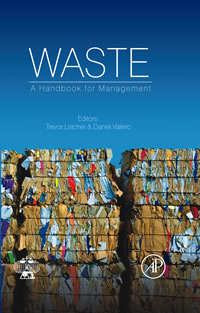|
|
Vol.
33 No. 3
May-June 2011
Trevor Letcher and Daniel Vallero (editors)
Elsevier, 2011
ISBN 978-0-12381-475-3
Waste: A Handbook of Waste Management looks at all the types of waste being generated in the world and includes chapters on waste generated in space and medical, urban, industrial, electronic, mine, radioactive, textile, paper, glass, battery, tire, metal paper, and agricultural waste. Other chapters focus on landfills, waste collection, waste regulations, risk assessment and accountability, green engineering of waste, air and marine pollution, and dangerous household chemicals. Chemistry is an important theme throughout the book, as most of the waste created in our society has a major chemical component.
 |
Waste is not new; it has been a problem for thousands of years. However, with the industrial and petrochemical revolutions, rapid growth in the world’s population, and greater consumerism, waste concerns have grown exponentially. Generally, engineers and scientists have done much to address previous problems long considered intractable (e.g., open dumps, lack of substitutes for dangerous products, and pesticides). Their work has encouraged a well-deserved dose of technological optimism, although the amount and hazardous nature of wastes continue to threaten society. The waste threat impinges on our public health and the integrity of ecosystems, it can compromise our aesthetic sensibilities, and it can be economically crippling. This crucial issue, often ignored in technical handbooks, is discussed in this book.
This book is designed to be a resource for the designer, practitioner, researcher, teacher, and student. Like other handbooks, this text seeks to include best practices and proper management of waste before, during, and after it is generated. Key to the usefulness of this handbook is its attention to the scientific challenge of how to achieve sustainable solutions to one of the most important of society’s problems: the management and elimination of waste in all its various forms, sectors, and waste streams. Obviously, no single resource is sufficiently comprehensive on its own in dealing with waste, so each of the chapters is richly annotated with additional references.
The main objectives in presenting all the issues related to waste in one volume are the following:
- to create a source book for easy consultation and for direction in further studies
- to provide a resource for helpful comparisons between different waste streams, leading to synergistic solutions
- above all, to help develop a better and more informed society
This handbook will be of particular interest to
- students and lecturers in science, engineering, and environmental studies
- researchers, who need the latest references
- parliamentarians and leaders in society, who need to be aware of the serious problems created by waste
- editors and journalists, who need to know the latest issues regarding waste
- captains of industry, technicians, and maintenance personnel, who need to be aware of the problems in their fields and related areas
- all interested parties, even more casual readers, whose awareness of the enormity of the problems surrounding waste will be enhanced
Perhaps the central value of this book, and how it differs from other books on similar themes, is its pragmatic perspective. Each chapter is written by an expert scientist or engineer working in the specific field and addresses a particular waste challenge. The book highlights the severity of each of the problems identified and offers the best solutions and recycling processes. In fact, one of the key values of this book is what it cannot say—that is, the chapter authors are upfront about uncertainties, and about areas in which advances and future research are needed.
The book is divided into three parts:
- Part 1, Introduction to Waste Management, which includes chapters on the history of waste management, green engineering and sustainable design as related to waste management, waste regulations, and waste collection
- Part 2, Waste Streams, which is a collection of 25 chapters on the most important waste streams in our society
- Part 3, Best Practice and Management, which contains chapters on landfills, pollution management and responsible care, and risk management and accountability of waste
www.iupac.org/web/ins/2008-039-2-600
Page
last modified 6 May 2011.
Copyright © 2003-2011 International Union of Pure and Applied Chemistry.
Questions regarding the website, please contact [email protected] |